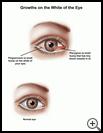
Growth on the White of the Eye (Conjunctiva)
________________________________________________________________________
KEY POINTS
- The conjunctiva is the clear membrane that lines the inside of your eyelids and covers the white of your eye. A pingueculum is a small clear or yellowish bump on the white of your eye. A pterygium is a small bump that has tiny blood vessels in it. This growth can get bigger and cover part of the clear outer layer on the front of your eye.
- If these growths do not cause any problems, they do not need to be treated. If the growths cause irritation or changes in your vision, they may be treated with eye drops or sometimes with surgery.
________________________________________________________________________
What is a growth on the conjunctiva?
The conjunctiva is the clear membrane that lines the inside of your eyelids and covers the white of your eye. There are two kinds of growths:
A pingueculum is a small bump on the white of your eye, usually on the side closest to your nose. The bump may be clear or yellowish.
A pterygium is a small bump that has tiny blood vessels in it. This growth can get bigger and cover part of your cornea, which is the clear outer layer on the front of your eye.
What is the cause?
These growths may be caused by:
- Long term exposure to irritants such as wind or dust
- Damaging chemicals
- Ultraviolet (UV) rays of the sun
They are more common in people who spend a lot of time outdoors, especially in sunny climates.
What are the symptoms?
Most commonly there are no symptoms. If you do have symptoms, they may include:
- Eye redness, itching or burning
- Dry, gritty eyes or watery eyes
- Blurry vision
How is it diagnosed?
These growths are often found during a routine eye exam. No special tests are needed.
How is it treated?
If these growths do not cause any problems, they do not need to be treated. If they cause redness, itching, or irritation, you can use eye drops called artificial tears. You can buy these products without a prescription. If these drops do not help, see your eye care provider. You may be prescribed stronger prescription drops.
A pterygium may grow and change the shape of your cornea, which can cause blurry vision. It can also block light entering your eye. A pterygium that causes vision problems can be removed with surgery.
These growths do not go away on their own. Sometimes they come back even after surgery.
How can I take care of myself?
Follow the full course of treatment your healthcare provider prescribes. Ask your healthcare provider:
- How and when you will get your test results
- How long it will take to recover
- If there are activities you should avoid and when you can return to your normal activities
- How to take care of yourself at home
- What symptoms or problems you should watch for and what to do if you have them
Make sure you know when you should come back for a checkup. Keep all appointments for provider visits or tests.
How can I help prevent growths on the conjunctiva?
Growths on the conjunctiva happen more often in sunny and windy areas. Wear sunglasses outdoors to help decrease the chance of developing these growths. It may also help to use artificial tears to prevent dry eyes.

